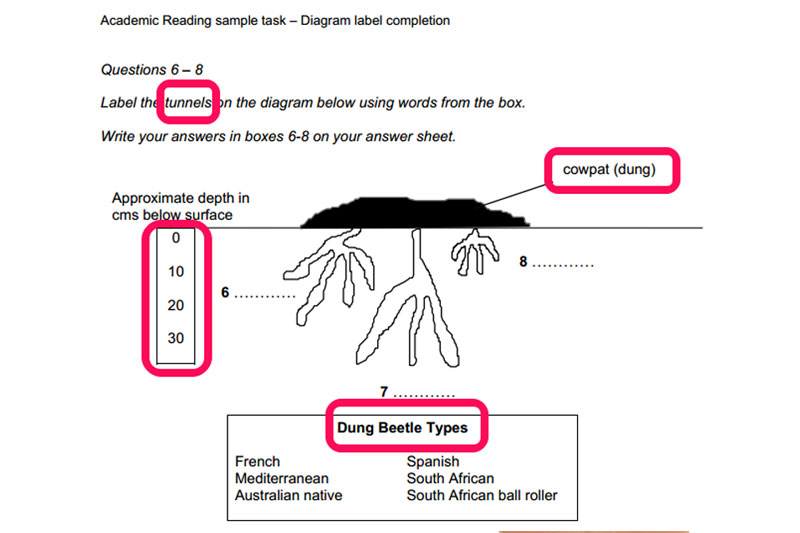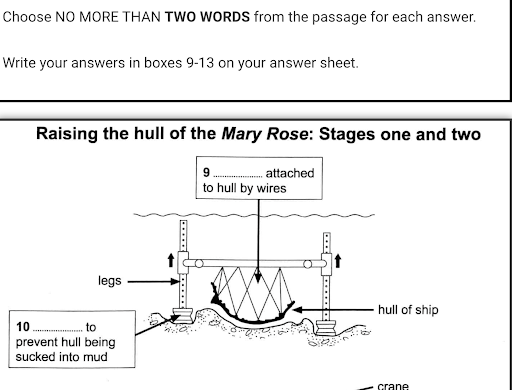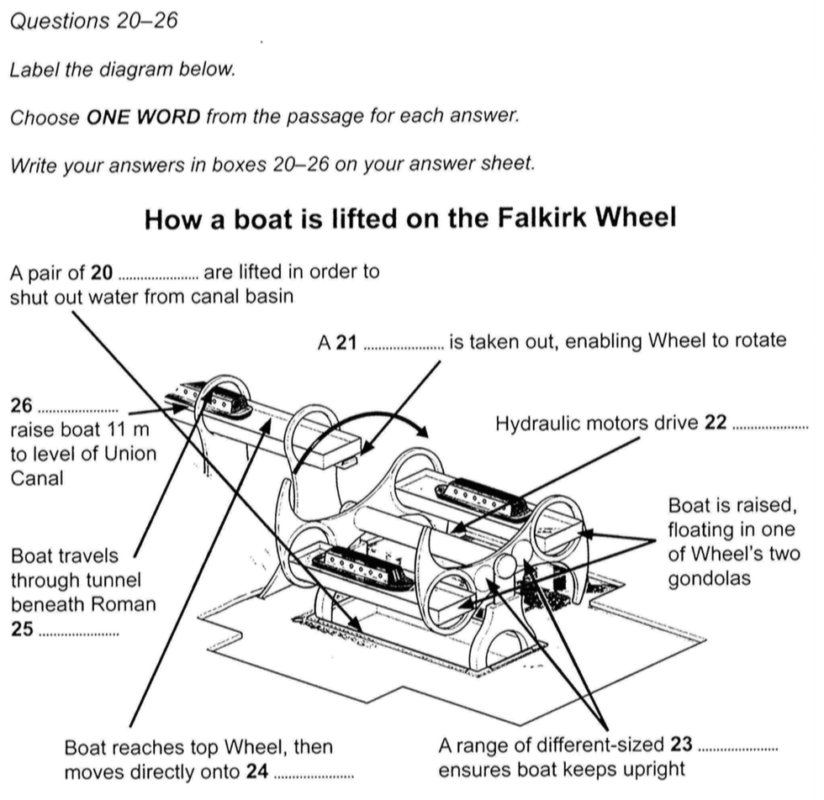Completing tables charts note diagrams là một dạng bài rất phổ biến trong bài thi IELTS Reading. Nhìn chung đây là một dạng bài không quá khó để xử lí, nhưng nếu không nắm bắt chính xác và luyện tập nhuần nhuyễn, chúng ta sẽ khó có thể đạt được band điểm tối đa khi gặp phải dạng bài này. Vì vậy, hãy cùng tìm hiểu kĩ hơn về dạng bài này để có thể chiếm trọn điểm số cho các câu hỏi liên quan nhé. Hãy cùng The IELTS Workshop tìm hiểu rõ hơn về cách làm cho dạng bài Completing Diagrams nhé.
1. Dạng bài Completing Tables Charts Note Diagrams là gì?
1.1. Khái niệm về dạng bài Completing Diagrams
Completing tables/charts/note/diagram hay Summary Completion và Flowchart Completion là những dạng bài tương tự nhau. Bạn phải sử dụng từ (words) trong bài đọc cho sẵn để điền vào chỗ trống. Completing Diagram yêu cầu thí sinh điền từ chú thích vào chỗ trống dưới dạng một biểu đồ. Dạng bài này có thể coi như một mảng nhỏ của dạng bài Gap-fill.

1.2. Các dạng bài Completing Diagrams
Đây là một dạng bài rất thường gặp. Vậy hãy cùng xem chúng xuất hiện như thế nào trong các bài thi IELTS Reading nhé.
Table Completion
Questions 1-5
Complete the table below.
Choose NO MORE THAN TWO WORDS from the passage for each answer.

Chart Completion
Question 11-13
Complete the flow-chart below.
Choose NO MORE THAN TWO WORDS from the passage for each answer

Note Completion
Question 8-13
Complete the notes below.
Choose ONE WORD ONLY from the passage for each answer.

Diagram Completion
Questions 20-26
Complete the diagram below.
Choose ONE WORD ONLY from the passage for each answer.

1.3. Các lỗi thí sinh hay mắc phải khi làm bài Completing tables, charts, note, diagrams
Khi làm bài Completing tables, charts, note, diagrams, thí sinh thường mắc phải những lỗi phổ biến sau:
- Vượt quá giới hạn từ cho phép: Đây là lỗi phổ biến nhất mà hầu như thí sinh nào cũng mắc phải ít nhất một lần. Có thể do quá tập trung vào việc đọc và tìm kiếm từ thích hợp để điền vào khoảng trống, mà chúng ta lại quên mất giới hạn từ đề bài cho phép. Điều này dẫn đến việc dù đã điền một câu trả lời có chứa nội dung chính xác như vẫn bị tính là sai do vượt quá giới hạn từ. Cách khắc phục cho vấn đề này rất đơn giản, đó chính là kiểm tra lại số lượng từ trong tất các câu trả lời sau khi đã điền xong.
- Điền sai từ cần thiết: Dù đã xác định được chính xác đoạn văn, câu văn chứa thông tin để trả lời câu hỏi, nhưng chúng ta vẫn có thể xác định sai từ cần điền vào khoảng trống. Điều này có thể do chưa đọc kĩ nội dung câu văn và thiếu sự nhận biết về các từ khoá đã được paraphrased. Vì vậy, chúng ta cần đọc cẩn thận và xác định đúng thứ tự các từ để chọn được từ chính xác điền vào khoảng trống.
- Viết sai chính tả: Có thể do quá chủ quan rằng đã tìm được đáp án chính xác, chúng ta thường vội vã điền vào khoảng trống mà viết sai chính tả. Vì vậy, cần dành thời gian kiểm tra lại tất cả các câu trả lời để đảm bảo chúng đều được viết đúng.
- Thí sinh không hiểu được câu hỏi đang hỏi gì. Trong một số trường hợp, đề bài đưa ra “quá khó”. Một số bài yêu cầu học thuật hoặc chuyên môn hóa cao. Các bài này yêu cầu phải nắm được từ vựng hoặc thuật ngữ chuyên ngành nếu muốn làm tốt. Tuy nhiên, những từ vựng chuyên môn cao cũng sẽ được hạn chế tránh làm khó thí sinh.
2. Cách làm dạng bài completing tables, charts, note, diagrams trong IELTS Reading
Dưới đây là 5 bước bỏ túi làm dạng bài completing tables, charts, note, diagrams:
- Bước 1: Đọc kỹ đề bài, xác định chính xác số từ cho phép điền vào chỗ trống.
- Bước 2: Xem xét và phân tích cấu trúc câu. Dựa vào ngữ pháp của câu bạn có thể đoán được loại từ sẽ điền. Cần lưu ý đa phần chú thích sẽ là một cụm danh từ thay vì là một câu hoàn chỉnh. Hãy chú ý điểm này sẽ giúp ích khá nhiều cho bạn trong việc xác định từ loại.
- Bước 3: Tìm và xác định được thông tin cần đọc trong bài để tìm từ điền vào chỗ trống. Kiểu bài này sẽ không yêu cầu bạn đọc quá nhiều. Thường thông tin chỉ nằm trong 1 – 2 đoạn văn. Lúc này, bạn hãy xem có từ chuyên môn nào không hiểu trong câu hỏi. Sau đó, xem trong bài đọc. Thông tin cung cấp thường sẽ không có quá nhiều từ chuyên môn cao.
- Bước 4: Scan bài đọc để có thể nắm được thông tin bài đọc và hiểu được cấu trúc câu.
- Bước 5: Xác định từ cần điền bằng việc so sánh thông tin giữa bài đọc và câu hỏi.
Nhìn chung, 1 bài Completion sẽ cần thỏa mãn 3 yếu tố sau: grammar, meaning và word limit.
Với ngữ pháp, từ điền cần đúng loại từ (danh từ, động từ, tính từ, trạng từ) trong câu. Từ đó khi điền vào câu cũng cần tạo ra một câu có nghĩa trong ngữ cảnh bài nghe đó. Cuối cùng, bạn chú ý nhìn số lượng từ cần điền (word limit) ở đề bài.
Các đáp án thường sẽ xuất hiện từ trên xuống dưới. Với dạng Table Completion, ngoài việc áp dụng các quy tắc trên, bạn cần để ý thêm về các categories và thông tin có vị trí cùng dòng cùng cột.
3. Áp dụng cách làm completing tables, charts, note, diagrams trong IELTS Reading
Bây giờ, chúng ta hãy cùng áp dụng các bước trên để xử lí một bài Table / Chart / Note / Diagram Completion sau đây nhé.
Ví dụ 1:
The medical benefits of the polar bear for humanity certainly have their importance in our conservation efforts, but these should not be the only factors taken into consideration. We tend to want to protect animals we think are intelligent and possess emotions, such as elephants and primates. Bears, on the other hand, seem to be perceived as stupid and in many cases violent. And yet anecdotal evidence from the field challenges those assumptions, suggesting for example that polar bears have good problem solving abilities. A male bear called GoGo in Tennoji Zoo, Osaka, has even been observed making use of a tool to manipulate his environment. The bear used a tree branch on multiple occasions to dislodge a piece of meat hung out of his reach. Problem-solving ability has also been witnessed in wild polar bears, although not as obviously as with GoGo. A calculated move by a male bear involved running and jumping onto barrels in an attempt to get to a photographer standing on a platform four metres high.
In other studies, such as one by Alison Ames in 2008, polar bears showed deliberate and focused manipulation. For example, Ames observed bears putting objects in piles and then knocking them over in what appeared to be a game. The study demonstrates that bears are capable of agile and thought-out behaviours. These examples suggest bears have greater creativity and problem-solving abilities than previously thought.
Note Completing
Question 8-13
Complete the notes below.
Choose ONE WORD ONLY from the passage for each answer.

Hướng dẫn cách làm
- Bước 1: Giới hạn từ cho phép ONE WORD ONLY.
- Bước 2: Tiêu đề ‘Reasons why polar bears should be protected’ và câu đầu tiên ‘People think of bears as unintelligent …’
- Bước 3: Scan bài đọc và xác định vị trí thông tin liên quan ‘protected’ à ‘conservations efforts’.
- Bước 4: Đọc hiểu nội dung phần thông tin đã tìm được trong bài đọc. ‘Bears, on the other hand, seem to be perceived as stupid and in many cases violent.’ à ‘Gấu thường được xem như một loài kém thông minh và thường hung hãn’
- Bước 5: Xác định chính xác thông tin cần điền bằng việc so sánh thông tin giữa bài đọc và câu hỏi.
‘people think of bears as’ = ‘bears seem to be perceived as’
‘unitelligent and in many casses violent’ = ‘stupid and …’
vậy thông tin cần điền là ‘violent’
- Bước 6: Kiểm tra lại tất cả câu trả lời xem để đảm bảo chính xác về giới hạn từ, chính tả, ngữ pháp, và ý nghĩa.
Đáp án: 8. violent – 9. tool – 10. meat – 11. photographer – 12. game – 13. frustration
Ví dụ 2:
Raising the Mary Rose
| On 19 July 1545, English and French fleets were engaged in a sea battle off the coast of southern England in the area of water called the Solent, between Portsmouth and the Isle of Wight. Among the English vessels was a warship by the name of Mary Rose. Built in Portsmouth some 35 years earlier, she had had a long and successful fighting career, and was a favourite of King Henry VIII. Accounts of what happened to the ship vary: while witnesses agree that she was not hit by the French, some maintain that she was outdated, overladen and sailing too low in the water, others that she was mishandled by undisciplined crew. What is undisputed, however, is that the Mary Rose sank into the Solent that day, taking at least 500 men with her. After the battle, attempts were made to recover the ship, but these failed. The Mary Rose came to rest on the seabed, lying on her starboard (right) side at an angle of approximately 60 degrees. The hull (the body of the ship) acted as a trap for the sand and mud carried by Solent currents. As a result, the starboard side filled rapidly, leaving the exposed port (left) side to be eroded by marine organisms and mechanical degradation. Because of the way the ship sank, nearly all of the starboard half survived intact. During the seventeenth and eighteenth centuries, the entire site became covered with a layer of hard grey clay, which minimised further erosion. Then, on 16 June 1836, some fishermen in the Solent found that their equipment was caught on an underwater obstruction, which turned out to be the Mary Rose. Diver John Deane happened to be exploring another sunken ship nearby, and the fishermen approached him, asking him to free their gear. Deane dived down, and found the equipment caught on a timber protruding slightly from the seabed. Exploring further, he uncovered several other timbers and a bronze gun. Deane continued diving on the site intermittently until 1840, recovering several more guns, two bows, various timbers, part of a pump and various other small finds. The Mary Rose then faded into obscurity for another hundred years. But in 1965, military historian and amateur diver Alexander McKee, in conjunction with the British Sub-Aqua Club, initiated a project called ‘Solent Ships’. While on paper this was a plan to examine a number of known wrecks in the Solent, what McKee really hoped for was to find the Mary Rose. Ordinary search techniques proved unsatisfactory, so McKee entered into collaboration with Harold E. Edgerton, professor of electrical engineering at the Massachusetts Institute of Technology. In 1967, Edgerton’s side-scan sonar systems revealed a large, unusually shaped object, which McKee believed was the Mary Rose. Further excavations revealed stray pieces of timber and an iron gun. But the climax to the operation came when, on 5 May 1971, part of the ship’s frame was uncovered. McKee and his team now knew for certain that they had found the wreck, but were as yet unaware that it also housed a treasure trove of beautifully preserved artefacts. Interest ^ in the project grew, and in 1979, The Mary Rose Trust was formed, with Prince Charles as its President and Dr Margaret Rule its Archaeological Director. The decision whether or not to salvage the wreck was not an easy one, although an excavation in 1978 had shown that it might be possible to raise the hull. While the original aim was to raise the hull if at all feasible, the operation was not given the go-ahead until January 1982, when all the necessary information was available. An important factor in trying to salvage the Mary Rose was that the remaining hull was an open shell. This led to an important decision being taken: namely to carry out the lifting operation in three very distinct stages. The hull was attached to a lifting frame via a network of bolts and lifting wires. The problem of the hull being sucked back downwards into the mud was overcome by using 12 hydraulic jacks. These raised it a few centimetres over a period of several days, as the lifting frame rose slowly up its four legs. It was only when the hull was hanging freely from the lifting frame, clear of the seabed and the suction effect of the surrounding mud, that the salvage operation progressed to the second stage. In this stage, the lifting frame was fixed to a hook attached to a crane, and the hull was lifted completely clear of the seabed and transferred underwater into the lifting cradle. This required precise positioning to locate the legs into the stabbing guides’ of the lifting cradle. The lifting cradle was designed to fit the hull using archaeological survey drawings, and was fitted with air bags to provide additional cushioning for the hull’s delicate timber framework. The third and final stage was to lift the entire structure into the air, by which time the hull was also supported from below. Finally, on 11 October 1982, millions of people around the world held their breath as the timber skeleton of the Mary Rose was lifted clear of the water, ready to be returned home to Portsmouth. |

Bạn có thể áp dụng cách làm bài để giải ví dụ theo các bước:
- Bước 1: Số từ được phép điền là 2 từ.
- Bước 2: Phân tích cấu trúc. Sau mệnh đề quan hệ “(which was) attached to hull by wires” sẽ cần điền một danh từ.
- Bước 3: Dựa vào các từ chuyên môn “hull”, “wire” để xác định thông tin trong bài.
- Bước 4: Scan thông tin trong bài. “The hull was attached to a lifting frame via a network of bolts and lifting wires”.“The problem of the hull being sucked back downwards into the mud was overcome by using 12 hydraulic jacks”.
- Bước 5: So sánh thông tin giữa câu hỏi và bài đọc, từ đó chọn ra đáp án
Đáp án: 9. Lifting frame; 10. hydraulic jacks
4. Lưu ý khi làm bài completing tables, charts, note, diagrams trong IELTS Reading
Sau khi đã nắm bắt được chiến lược chính để xử lí dạng bài này, chúng ta hãy cũng lưu ý lại một số vấn đề nhé:
- Các câu hỏi thường đi theo thứ tự thông tin xuất hiện trong bài đọc.
- Câu trả lời cho các câu hỏi thường nằm trong các câu, đoạn văn liền kề.
- Đọc kỹ hướng dẫn và đảm bảo điền thông tin đúng với giới hạn về số lượng từ cho phép.
- Kiểm tra chính tả của tất cả câu trả lời.
- Chú ý đọc hiểu nội dung và từ khoá đã được paraphrased.
5. Bài tập thực hành
Bài tập 1:
Choose one word from the passage for each answer.
Write your answers in boxes 20 – 26 on your answer sheet.
The Falkirk Wheel
| The Falkirk Wheel in Scotland is the world’s first and only rotating boat lift. Opened in 2002, it is central to the ambitious £84.5m Millennium Link project to restore navigability across Scotland by reconnecting the historic waterways of the Forth & Clyde and Union Canals. The major challenge of the project lays in the fact that the Forth & Clyde Canal is situated 35 metres below the level of the Union Canal. Historically, the two canals had been joined near the town of Falkirk by a sequence of 11 locks – enclosed sections of canal in which the water level could be raised or lowered – that stepped down across a distance of 1.5 km. This had been dismantled in 1933, thereby breaking the link. When the project was launched in 1994, the British Waterways authority were keen to create a dramatic twenty-first-century landmark which would not only be a fitting commemoration of the Millennium, but also a lasting symbol of the economic regeneration of the region. Numerous ideas were submitted for the project, including concepts ranging from rolling eggs to tilting tanks, from giant seesaws to overhead monorails. The eventual winner was a plan for the huge rotating steel boat lift which was to become The Falkirk Wheel. The unique shape of the structure is claimed to have been inspired by various sources, both manmade and natural, most notably a Celtic double headed axe, but also the vast turning propeller of a ship, the ribcage of a whale or the spine of a fish. The various parts of The Falkirk Wheel were all constructed and assembled, like one giant toy building set, at Butterley Engineering’s Steelworks in Derbyshire, some 400 km from Falkirk. A team there carefully assembled the 1,200 tonnes of steel, painstakingly fitting the pieces together to an accuracy of just 10 mm to ensure a perfect final fit. In the summer of 2001, the structure was then dismantled and transported on 35 lorries to Falkirk, before all being bolted back together again on the ground, and finally lifted into position in five large sections by crane. The Wheel would need to withstand immense and constantly changing stresses as it rotated, so to make the structure more robust, the steel sections were bolted rather than welded together. Over 45,000 bolt holes were matched with their bolts, and each bolt was hand-tightened. The Wheel consists of two sets of opposing axe-shaped arms, attached about 25 metres apart to a fixed central spine. Two diametrically opposed water-filled ‘gondolas’, each with a capacity of 360,000 litres, are fitted between the ends of the arms. These gondolas always weigh the same, whether or not they are carrying boats. This is because, according to Archimedes’ principle of displacement, floating objects displace their own weight in water. So when a boat enters a gondola, the amount of water leaving the gondola weighs exactly the same as the boat. This keeps the Wheel balanced and so, despite its enormous mass, it rotates through 180° in five and a half minutes while using very little power. It takes just 1.5 kilowatt-hours (5.4 MJ) of energy to rotate the Wheel -roughly the same as boiling eight small domestic kettles of water. Boats needing to be lifted up enter the canal basin at the level of the Forth & Clyde Canal and then enter the lower gondola of the Wheel. Two hydraulic steel gates are raised, so as to seal the gondola off from the water in the canal basin. The water between the gates is then pumped out. A hydraulic clamp, which prevents the arms of the Wheel moving while the gondola is docked, is removed, allowing the Wheel to turn. In the central machine room, an array of ten hydraulic motors then begins to rotate the central axle. The axle connects to the outer arms of the Wheel, which begin to rotate at a speed of 1/8 of a revolution per minute. As the wheel rotates, the gondolas are kept in the upright position by a simple gearing system. Two eight-metre-wide cogs orbit a fixed inner cog of the same width, connected by two smaller cogs travelling in the opposite direction to the outer cogs – so ensuring that the gondolas always remain level. When the gondola reaches the top, the boat passes straight onto the aqueduct situated 24 metres above the canal basin. The remaining 11 metres of lift needed to reach the Union Canal is achieved by means of a pair of locks. The Wheel could not be constructed to elevate boats over the full 35-metre difference between the two canals, owing to the presence of the historically important Antonine Wall, which was built by the Romans in the second century AD. Boats travel under this wall via a tunnel, then through the locks, and finally on to the Union Canal. |

Đáp án
| 20. gates | 21. clamp | 22. rotate | 23. cogs | 24. aqueduct | 25. wall | 26. locks |
Bài tập 2:
Table Completion
Questions 1-5
Complete the table below.
Choose NO MORE THAN TWO WORDS from the passage for each answer.

B. Research shows that when a bilingual person uses one language, the other is active at the same time. When we hear a word, we don’t hear the entire word all at once: the sounds arrive in sequential order. Long before the word is finished, the brain’s language system begins to guess what that word might be. If you hear ‘can’, you will likely activate words like ‘candy’ and ‘candle’ as well, at least during the earlier stages of word recognition. For bilingual people, this activation is not limited to a single language; auditory input activates corresponding words regardless of the language to which they belong. Some of the most compelling evidence for this phenomenon, called ‘language co-activation’, comes from studying eye movements. A Russian-English bilingual asked to ‘pick up a marker’ from a set of objects would look more at a stamp than someone who doesn’t know Russian, because the Russian word for ‘stamp’, marka, sounds like the English word he or she heard, ‘marker’. In cases like this, language co-activation occurs because what the listener hears could map onto words in either language.
C. Having to deal with this persistent linguistic competition can result in difficulties, however. For instance, knowing more than one language can cause speakers to name pictures more slowly, and can increase ‘tip-of-the-tongue states’, when you can almost, but not quite, bring a word to mind. As a result, the constant juggling of two languages creates a need to control how much a person accesses a language at any given time. For this reason, bilingual people often perform better on tasks that require conflict management. In the classic Stroop Task, people see a word and are asked to name the colour of the word’s font. When the colour and the word match (i.e., the word ‘red’ printed in red), people correctly name the colour more quickly than when the colour and the word don’t match (i.e., the word ‘red’ printed in blue). This occurs because the word itself (‘red’) and its font colour (blue) conflict. Bilingual people often excel at tasks such as this, which top into the ability to ignore competing perceptual information and focus on the relevant aspects of the input. Bilinguals are also better at switching between two tasks; for example, when bilinguals have to switch from categorizing objects by colour (red or green) to categorizing them by shape (circle or triangle), they do so more quickly than monolingual people, reflecting better cognitive control when having to make rapid changes of strategy.
Đáp án: 1. eye movements – 2. language co-activation – 3. Stroop Task – 4. Conflict management – 5. cognitive control
Hy vọng rằng bạn đã nắm được chiến thuật để làm bài completing tables, charts, note, diagrams hiệu quả. Để học thêm các phương pháp làm bài cho từng dạng bài cụ thể trong IELTS Reading, bạn có thể tham khảo khóa học Senior của The IELTS Workshop nhé.









